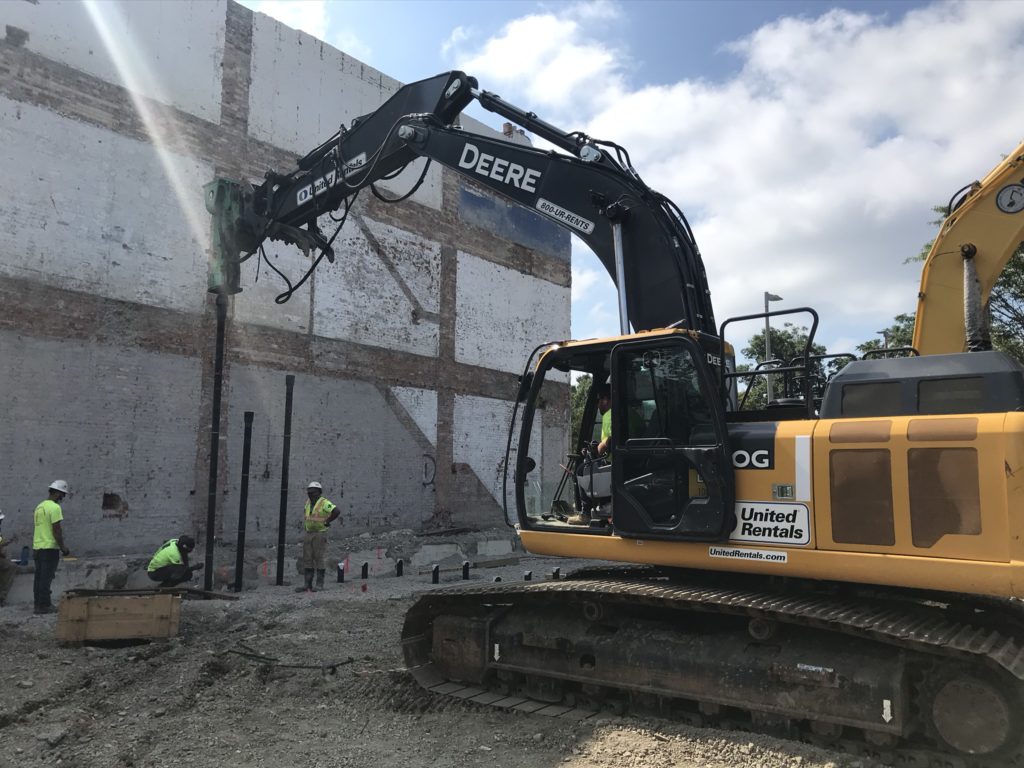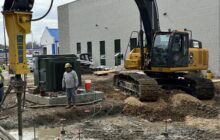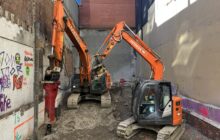Ductile Iron Piles provided a low vibration foundation solution to support the building adjacent to the existing residential building.
Project Description:
The project consisted of a new 32,000 sq ft, 6-story residential building in the Allston neighborhood of Boston. The building included a 3,300 sq ft basement in one corner. Construction was planned immediately adjacent to an existing 4-story residential row-house building, requiring a low vibration foundation solution.
Geotechnical Conditions:
Soil conditions consisted of loose to very dense urban fill ranging from 2 to 18 feet below grade. In the southern third of the site, soft to stiff organic silt with peat was encountered below the fill and extended to depths of 10 to 18 feet. The fill and organics were underlain by glacial outwash sand followed by marine clay. Glacial till was encountered at a depth of about 45 feet and extended to at least 68 feet where the deepest boring terminated. Groundwater was encountered at depths of 6 to 13 feet below grade.
Project Challenges:
Provide a low vibration foundation solution to support the building adjacent to the existing residential building.
Advantages
- Low vibrations
- Rapid installation
- Cost-savings compared with micropiles
- Easily adjust to changing ground conditions
- Demonstrated capacity through load testing
Design and Construction Solution
With fill and organics on the site, an intermediate or deep foundation solution was needed to support the new structure and control settlement. The geotechnical engineer recommended the use of rigid inclusion ground improvement across the site except for foundations adjacent to the existing building where vibrations were a concern and in the proposed basement area where delayed foundation cut-off would be required. Ductile Iron Piles and drilled micropiles were recommended for these areas.
The project team compared both piling options and selected Ductile Iron Piles based on both lower cost and reduced schedule. A Series 118/9.0 Ductile Iron Pile was proposed with a working capacity of 50 tons (compression). The design required piles be driven through the fill, organics and clay to terminate by achieving set in the glacial till or on rock.
A pre-production load test program was performed by DIP contractor Helical Drilling, Inc. The Series 118/9.0 test pile was installed along with four exterior grouted Ductile Iron Piles to serve as reaction piles to resist the tension loads during the test. The test pile advanced to 75 feet prior to achieving a set of 1” or less in 50 seconds. The pile was loaded up to 200% of the design load (100 tons) where a deflection of 1.20 inches was recorded after completing the creep hold period. The test was then rebounded with only 0.15 inches of net (permanent) deflection at the alignment load. The response was nearly linear and elastic and confirmed the 50 ton design capacity of the piles.
With the successful load test completed, the crew installed 38 Ductile Iron Piles in 3 working days followed by a day to perform the interior grouting of the piles. The pile lengths at production locations increased from the planned lengths and extended up to 88 feet. The Plug and Drive connection of the modular Ductile Iron Piles allowed for easy adjustment to address the changing ground conditions and longer piles with no wasted material. The use of the low vibration Ductile Iron Piles provided a rapid and cost-effective solution to support the foundation loads.
Project Team Members
DIP Design/Build Partner: Helical Drilling, Inc.
Geotechnical Engineer: McPhail Associates, LLC
General Contractor: D.F. Pray, Inc.
Structural Engineer: Roome & Guarracino, LLC






